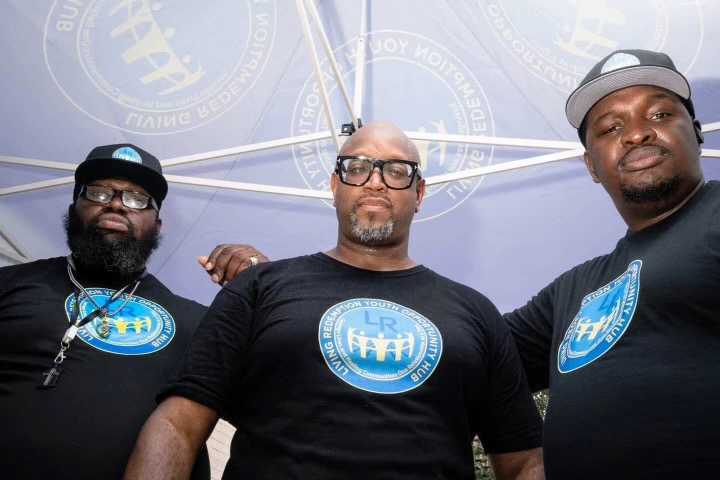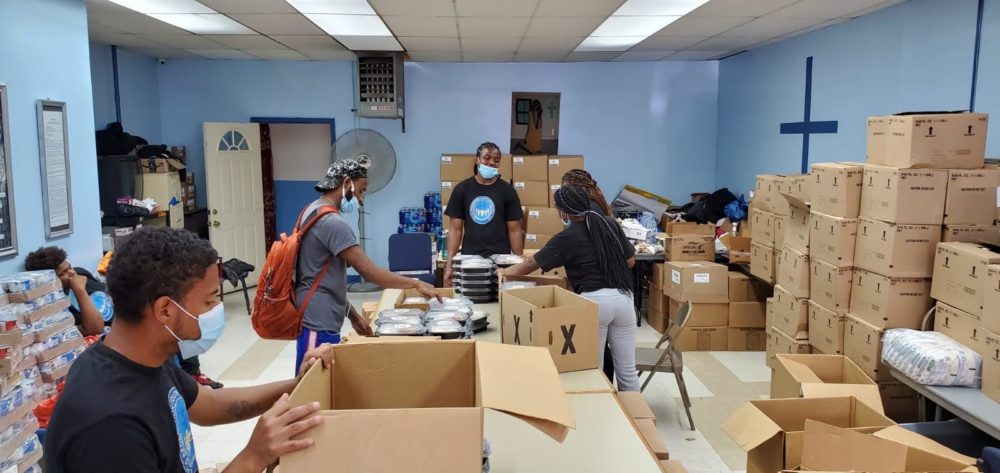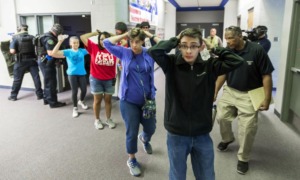Just weeks into his second prison stay — serving a 23-month sentence for charges including gun possession and attempted murder — Dedric “Bad News” Hammond decided to course-correct. He found a path forward in the pages of a Bible, changed his nickname from Bad News to Beloved and returned to the same streets where he’d run amok. But, this time, he’d be using his past to help young people avoid or get out of the kind of criminality he left behind.
“If you went to a hospital and the doctor had to work on you, he’s not going to just know [what to do]. He’s going to ask questions and he’s going to ask the right questions. Where do you hurt? When did it start? How do you cope?” said Hammond, one of 10 “credible messenger” mentors at Living Redemption Youth Opportunity Hub in Central Harlem.
“We’re street doctors,” he continued. “We need to know where the pain lies.”
Previously incarcerated men and women, those messengers are central to four-year-old Living Redemptions’ self-styled approach to steering youth and young adults away from violence and crime, mainly by tackling the trauma, stress, loss, abuse and inequality that many of them have experienced.  Being from similar neighborhoods and backgrounds as local gang members and kids on the cusp of delinquency grants the messengers a unique access and legitimacy.
Being from similar neighborhoods and backgrounds as local gang members and kids on the cusp of delinquency grants the messengers a unique access and legitimacy.
Headquartered in the upper rooms of a church on 124th Street, Living Redemption is one of five such hubs that, in 2017, received $45.9 million of $250 million that the Manhattan District Attorney’s Office seized from a drug-money laundering European bank. Decade-old Living Redemption got $10.3 million.
The windfall, said the Rev. Maurice Winley, Living Redemption’s founder and executive director, turned “a part-time credible messengers program into a comprehensive credible messenger agency” and a fully incorporated, expanding nonprofit, serving more youth and providing a paycheck for those mentoring messengers. “We can give them a salary that is worth the work that they are doing, with benefits,” Winley said. “So, now, instead of being part of the problem, they are positioned to be part of the solution … [We’re] breaking generational cycles.”
Hub helps formerly incarcerated youth, their kin and neighbors
As of spring 2021, 85% of the young people at Living Redemption were previously involved with the justice system, according to the Manhattan DA’s Criminal Justice Investment Initiative. The remaining 15% are those justice-involved youths’ younger siblings and cousins, children of participants and mentors and youth and young adults who Living Redemption’s leaders have gotten to know while working in the community.
On any given afternoon, between 20 and 60 youth flood the second and third floor of Soul Saving Station Church, which houses Living Redemption. Some cluster into classrooms for formal check-ins with the credible messengers who are ensuring that youth meet the goals of their individualized juvenile justice re-entry programs. Kids and teens barrel through the large community room with alternating blue and purple walls, eager to snatch up a video-game controller. Toddlers — offspring of both mentors and participants — ramble among the rooms.
“Schools had called us one day and asked, ‘How is it that you got all these kids coming here?’” mentor Hammond recalled. He assured the inquiring educators that Living Redemption is an actual program. But more than a program, he added, “We got to consider it as a way of life. We call it the living room effect. They get to drop their head down, drop the facade and really open up and be themselves.”
“They give you a space and opportunity to be who and what you are,” said Naashon Rivers Jr., a mentee of Hammond’s since 2017. “I loved it the first day I got there because they pretty much was offering a lot of help I wasn’t getting.”
Living Redemption’s team helped the high school dropout, now 27, find housing, jobs, play in community basketball leagues and, most recently, earn his general educational diploma.

Living Redemption Youth Opportunity Hub
Some of the adult leaders and mentors at Living Redemption Youth Opportunity Hub.
“That’s family there,” Rivers said. “That whole building is family.”
He repeats that thought to newcomers to the hub: “You’re in a great home, a safe haven. Let all your frustrations out. It’s nothing they can’t handle.”
Those creds are what caught the Manhattan DA’s attention, said Danielle Mindess, director of that office’s justice reinvestment initiative.
More than some other applicants for those funds, Living Redemption proved it was intimately aware that a young person’s adverse life circumstances raises his or her risks for arrests and incarceration, said Patrick Hart, program director for the Institute for State & Local Governance. That City University of New York institute helped select which organizations would be funded, oversees the programs and has been documenting their impact.
“Young people were calling them day and night,” said Hart, describing Living Redemption’s level of involvement. From youth asking for subway fare or notifying someone that they’d been arrested, those calls ran the gamut. And the credible messengers showed up to address their problems, large and small.
Hart has witnessed Living Redemption’s work firsthand. He’s heard young people talk candidly about their violent urges, then listen attentively as Hammond rebuked violence. “Seeing the connection — these young people weren’t rolling eyes, they were listening — to me, that was powerful,” Hart said.
What also tipped the scales in Living Redemption’s favor is its partnerships with more than 20 agencies: Counseling services at Full Circle Life Enrichment Center, athletic facilities at Bethel Gospel Assembly and arts programs at Thrive Collective.
During COVID-19, Living Redemption’s justice-involved youth served the needy
Since the 2017 infusion of cash, Living Redemption has served 685 young people.
Amid COVID-19’s stay-at-home orders in Spring 2020, some of them found ways to give back some of what Living Redemption has poured into them. When their in-person mentoring was put on hold and programming went online, those youth, Winley and the credible messengers began distributing donated food from their space on 124th. So far, 24,351 families have benefitted from that project, whose outgrowth is a permanent food pantry that Living Redemption now is creating.
During some days of the pandemic food giveaway, said Rivers, Hammond’s mentee, said he biked to the hub during his work breaks to help or to encourage people, many of whom lost jobs during the pandemic, waiting in line. He even helped a few people find housing, he said. “The more I did it, the happier I was. I understand where they at because I was once them. I was excited to see their smile on their face.”
During those giveaways, messenger Hammond said, he listened as kids who’d rarely spoken and tended to stay to themselves started chatting up others, passing out water to those waiting in line for food, giving and following directions. In addition to bagging and distributing food, the youth also dished up chicken and mac-and-cheese to those who arrived for community meals at Living Redemption.
“They hear me say, ‘I love you,’” Hammond said. “So they go from being served to serving.”
Researcher: Will “credible messenger” program funding continue?
Baz Dreisinger, founder of the Prison-to-College Pipeline at John Jay College of Criminal Justice in Manhattan, said she is thrilled that credible messengers are actual employees at Living Redemption and elsewhere.
Nevertheless, she is concerned about whether and how that workforce will be sustained.
Also, she added, deploying people who have been involved in the justice system to the front lines of community violence can have mixed results: “How do you take care of the well-being of your staff? How do you avoid exploiting this population?”
Winley does not share those or other worries. Though the DA’s grant ended on June 30th, his team continues to search out and secure new funding.
Trailing check-ins by the DA’s office and City University’s governance institute, an outside firm is taking a deeper look at the numbers, trying to determine what the Living Redemption delivers, in the way of youth staying out of prison and so forth, in return for its funding.
“I can’t say what the evaluation will show, but based on what we’ve heard we believe they have reduced involvement with the system,” said Hart, the City University program coordinator.
While others are crunching the numbers, Living Redemption is forging on, Winley said.
Before launching Living Redemption, Winley worked as director of credible messenger mentoring at Community Connections for Youth, a non-profit that helps grassroots organizations develop alternatives to youth-incarceration. He led credible messenger boot camps and trainings across the country and still offers technical support to other credible messenger start-ups.
At Living Redemption, Winley continues to help credible messengers sharpen their self-awareness and introspection. He does a weekly inspiration meeting, that’s separate from routine staff meetings. There, the messengers share thoughts, ideas and concerns, pray and read scripture together. Winley also gets one-on-one time with the credible messengers several times each week.
“I’m available to them 24/7,” he said, “the way they are available to our participants 24/7.”
































